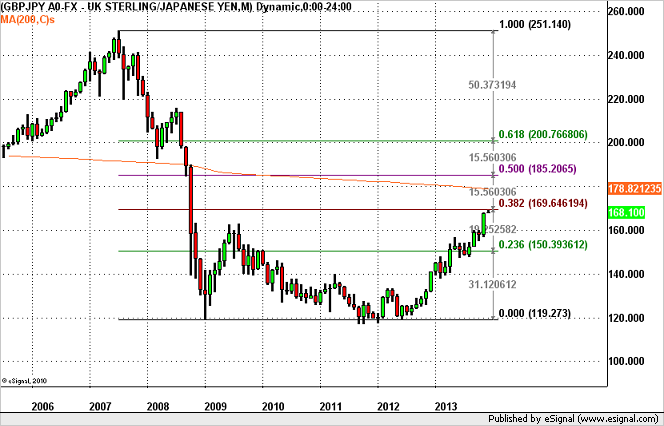With no U.S. economic reports scheduled for release today, we want to take this opportunity to talk about one of the strongest trending currency pairs in the forex market. Since the beginning of the year we have seen solid gains in GBP/JPY. Over the past 11 months, the pair appreciated nearly 20% to its highest level in 5 years. A 20% rally for a stock would be considered a big move but for a currency pair, which should generally not have this much volatility, it is even more significant. Thankfully, the U.K. is not a major exporter to Japan so a strong currency is not materially damaging to the U.K. economy. In contrast, the weaker the Yen, the better it is for Japan. After a 20% rally, it is not a surprise that many forex traders are wondering how much higher can GBP/JPY rise. At bare minimum, we expect the currency pair to hit 170 with a 70% chance of the move extending to 175. 180 may be a bit of a stretch but not out of realm of possibility. To understand why another 5% rise in GBP/JPY is possible, lets take a look at the outlook for the currency pair from fundamental, technical and positional perspective.
To Each His Own
From a fundamental perspective, the British pound has reasons to rise and the Yen has reasons to fall. This morning another piece of strong U.K. data pushed GBP/JPY to fresh multi year highs. With manufacturing and construction sector activity accelerating in the month of November, the outlook for the U.K. is looking brighter by the day. The Bank of England already admitted that their unemployment rate target could be reached a year sooner than they previously forecasted and if the country's PMI reports continue to surprise to the upside, not only will investors position for even earlier tightening by the BoE but the central bank may have to start dropping its dovish bias. The market is currently pricing in 2 rate hikes in mid to late 2015 but these expectations could easily shift to late 2014, early 2015 if the data supports it. The faster the unemployment rate falls, the stronger sterling will rise. The outperformance of the U.K. economy is expected to continue in the coming year thanks in large part to the ongoing support that the government has provided to the housing market. In October the U.K. government even brought forward its Help to Buy scheme which was originally planned for January 2014 to ensure a continued recovery in the sector and for this reason, we believe that the economy is well positioned for stronger growth in the first half of 2014.
In contrast, Japanese fiscal and monetary policies should keep the Yen in a downtrend. The unprecedented amount of stimulus provided by the Bank of Japan this past year and Abenomics has and should continue to provide support for the Nikkei as well as the Yen crosses. The outlook for GBP/JPY is largely contingent on the outlook for USD/JPY. We have gradually seen the spread between U.S. and Japanese 10 year yields widen and this trend is widely expected to continue in the coming year. Positive U.S. economic surprises have investors waffling between December, January and March for the first tapering by the Federal Reserve. Regardless of whether the central bank chooses to reduce asset purchases, there is no question that they will start paring stimulus within the next 4 months. More importantly, when they announce their plan to reduce monthly bond purchases, it may include a schedule to bring asset purchases to zero. Last year Bernanke said Quantitative Easing will end in 2014 and given the urgency heard in the voices of some policymakers who vote next year, we believe they will stick to this timeline. This means the dollar will not only receive support from a tapering itself but also the prospect of QE ending.
Strong Relationships
The following chart shows the relationship between GBP/JPY (white line), the spread between U.S. and Japanese 10 year yields (Green line) and the spread between U.K. Japanese 10 year yields (Orange line). As you can see, the relationship is very strong and this suggests that when global growth is on the rise, the US-JN and UK-JN spreads move in the same direction.
 GBP/JPY And Yields" title="The GBP/JPY And Yields" align="bottom" border="0" height="415" width="580">
GBP/JPY And Yields" title="The GBP/JPY And Yields" align="bottom" border="0" height="415" width="580">
From a technical perspective, we have to turn to the monthly chart to find resistance in GBP/JPY. With the former 2009 high of 163 behind us, the next resistance level for GBP/JPY is right below 170, the 38.2% Fibonacci retracement of the 2007 and 2008 sell-off. Above that is the 200-day SMA at 178.80 but the psychological importance of 175 could make this level a stopping point.
 GBP/JPY: Monthly" title="GBP/JPY: Monthly" align="bottom" border="0" height="372" width="580">
GBP/JPY: Monthly" title="GBP/JPY: Monthly" align="bottom" border="0" height="372" width="580">
From the perspective of positioning, the latest IMM report showed short Yen positions near a seven-year high. Speculative positions continued to build over the past few weeks with Yen short or long USD/JPY positions increasing. Sterling positions on the other hand are flat, which suggests that there is still scope for speculators to build long GBP and GBP/JPY positions. The only risk is that whenever we have Yen short positions at such extreme levels, the currency is very vulnerable to profit taking but so far we have not seen that. As a result, we are still looking for further gains in GBP/JPY in the coming year.
 GBP/USD Positions" title="GBP/USD Positions" height="256" width="580">
GBP/USD Positions" title="GBP/USD Positions" height="256" width="580">
Kathy Lien, Managing Director of FX Strategy for BK Asset Management.
